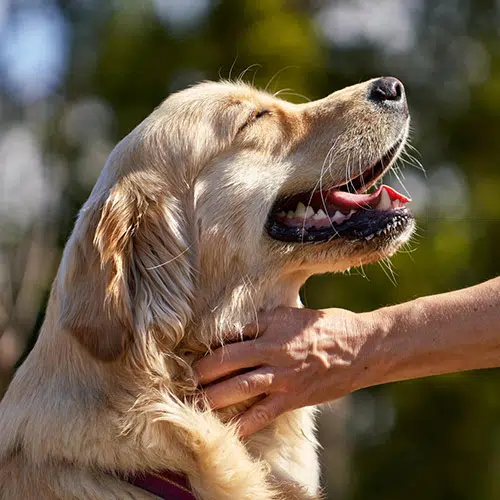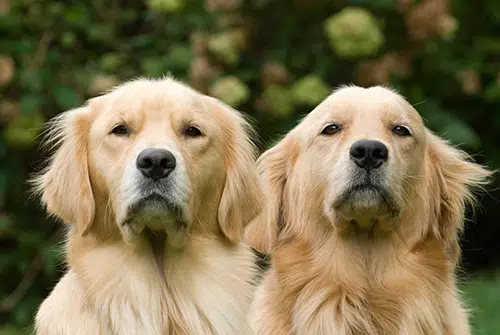You may have heard the term golden retriever feathers several times, especially when interacting with dog owners.
And you may ask yourself, “what are golden retriever feathers?”
Feathers grow on Golden Retriever dogs, which are the main distinctive feature of this breed.
The Golden Retriever is among the most recognized dog breeds in the US.
It was ranked fourth most popular dog in America in 2020.
Let’s have a closer look at Golden Retriever feathers and learn more about how to take care of this unique characteristic of a Golden.
What Are Golden Retriever Feathers?
Golden Retriever feathers are terms given to a rare physical trait found in Golden Retrievers.

These dogs have long, soft, dense hair that looks like fluffy feathers. The feathers are found in different parts of the Golden’s body.
Feathers add to the dog’s beauty so that you can’t get enough of their gorgeous sight.
Golden dogs have two layers of coats; the undercoat, which is short and fuzzy, and the long, smooth, water-repellent outer coat.
The Golden Retriever feathers help protect against harmful ultraviolet (UV) rays and also help them stay warm during the cold weather.
Which Parts of the Golden Retriever Can You Find Feathers?
You can find Golden Retriever feathers in different parts of the dog’s body.
The American Kennel Club (AKC) provides a guide that indicates which parts you can find feathers on a Golden Retriever.
- Back of forelegs
- Underbody
- Front of the neck
- Back of the thighs
- The underside of the tail
The feathers should also be:
- Dense and waterproof:
- Firm and resilient
- Not coarse nor silky
- Straight or wavy
- Long and not shaved
The Golden Retriever feathers layout differentiates a Golden from other breeds.
What Color Are They?
According to the American Kennel Club (AKC), a Golden Retriever’s color should be a rich, lustrous golden shade.
In addition, it should not be too dark, nor too light.
The same applies to its feathers.
Here are the golden shades that fit the above description:
- Light golden
- Golden
- Dark golden
You can also find Golden Retriever with colors that don’t match the AKC standards, but they’re purebred.
This may be because they inherited throwback genes.
They are cream golden or red gold.
It’s important to keep in mind that the feathers don’t have to match the coat color completely; they might be a shade darker or lighter.
There’s no need to worry about the colors as long as you don’t want to enter your furry friend into a competition.
Are They the Same for All Retrievers?
No. Golden retrievers don’t have the same feathering.
This is because there are different types of Golden Retriever.
But they all have the same golden colors.
- Canadian Golden Retriever: They typically have a lighter shade than the American Golden Retriever. They are leaner and taller than British and English Golden, and their fur darker, short, and thin. This makes them shed less fur compared to the other types.
- British Golden Retriever: They have a lighter shade than the American Golden Retriever. Mostly they have the golden cream color. Also, their head is larger, with a square muzzle. They have a good amount of feathers and are shorter and sturdier.
- American Golden Retriever: Are thinner and taller, with long feathering and darker fur. In addition, the American Golden is bigger than the English Golden Retriever.

Are Golden Retriever Born With Feathers?
No. Golden Retrievers are born without feathers.
A Golden Retriever’s puppy is born with soft, fuzzy fur.
When the puppy is around three, you’ll start noticing the growth of feathers.
The start of the feather growth process is an exciting time for dog owners.
They can’t hide their excitement when those small hairs start to pop.
The process begins on the tail, proceeds to the legs, and then the stomach.
But this is not the case for every puppy.
Like human hair, the growth of a Golden feather depends on genetics, health, and the type of diet you feed your dog.
Most Golden Retrievers have their full feathering when they are a year old.
The adult coat grows on the rest of the body over time.
So by the age of 18 months, your Golden Retriever will have grown into their full adult coat, which will be darker than the one they had as a puppy.
A dog that spends most of its time outdoors has thick fur compared to one indoors most of the time.
The growth of an adult coat for the Goldens differs from other dog breeds.
It’s good to note that the Golden Retriever never sheds its puppy fur.
Instead, the adult fur pushes it aside. And this is where the second coat comes from.
How To Groom Golden Retriever Feathers
It’s good to groom your Golden Retriever feathers earlier.
The best time is when it’s still a puppy.
The Golden lightly sheds its fur throughout the year but sheds heavily twice a year.
Don’t blame the feathers. The culprit is the undercoat.
Grooming your Golden helps in the shedding process since you’ll be able to remove loose fur and help remove tangled hair.
It also helps enhance the growth of the new coat.
Good feather grooming will maintain your dog’s luscious look and keep him healthy.
Grooming the Golden Retriever feathers involves:
- Brushing the feathers 3 – 4 times a week
- Bathing your dog at least once a month
- Trimming the feathers(on a need basis)
- Visiting a professional groomer every 6 – 10 weeks.
If your Golden attends confirmation shows or takes part in therapy work, it’s good to groom them every show or visit.
Grooming your golden feathers need not take your time, especially if you do it consistently.
However, irregular grooming can lead to feathers matting, and your dog can start smelling.
Steps for Grooming a Golden Retriever Feather
- Brushing: Ensure that your dog is as comfortable as possible. You can start by playfully touching its body. Shower your canine buddy with praises and let them know you want to groom them. You can also play some relaxing tunes.
- Trimming: Back brush each section from head to toes. Ensure that you untangle matted fur to avoid hurting the dog. You can use a detangling dog spray and a slicker or pin brush to brush the hair with ease. You can trim the dog feathers at this point if you notice they need trimming. A pair of scissors and trimmers are enough for cutting the feathers.
- Bathing: Soak your Golden in warm water with shampoo. You can use a slicker brush to remove loose hair. Dry them off with a towel and then with a canine hairdryer. Brush them one more time and top it off with a moisturizing dog spray (optional).
Is It OK to Give a Golden Trimmer a Haircut?
Avoid shaving your Golden Retriever’s feathers to preserve their purpose and give your Golden its complete aesthetic look.
Golden Retrievers will naturally shed their fur, so shaving them more will leave them exposed to harsh ultraviolet (UV) rays.
This can lead to sunburns, irritation, and excess heat.
Also, shaving a Golden Retriever during cold weather exposes them to cold, which can cause serious health problems.
Is Visiting a Professional Groomer Necessary For Your Golden?
Even if you regularly groom your Golden Retriever’s feathers, it’s good for them to visit a professional groomer at least after six weeks.
Many benefits come with visiting a groomer:
- They can help detect any skin diseases.
- Safely remove stubborn mats on the feathers
- They can offer unique treatments to your dog.
- Checking if there are fleas and ticks
- Saves your time
Take Away
If you’re asked, “what are Golden Retriever feathers”? Just say this is the long, feather-soft hair found on Golden Retriever breeds.
Their colors are lightly golden, golden, dark golden, golden cream, and red-golden.
Taking good care of your Golden Retriever feathers is crucial for them to preserve their gorgeous fur coats.
